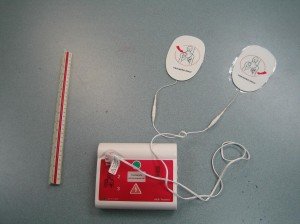An AED or automated external defibrillator has been a life-saving device that might only be used during emergencies such as sudden cardiac arrest. Whether an AED is utilized on a daily basis by an emergency medical provider or bought as a workplace safety measure that is never used, it must be checked regularly to ensure that it will function properly when needed in order to save a life during emergency scenarios.
It is important to check all the parts of an AED on a regular basis to ensure properly functionality at all times. If you want to learn how to use an AED, click here.
Electrodes
Initially, check the electrode package. Make sure that the package is properly sealed because if not, the electrode adhesive will eventually dry out. Obviously, this will render the device useless since the monitor senses the rhythm of the heart through the electrode pads. If the monitor could not sense the heartbeat, it will continue to instruct the user to check the adhesion of the electrode. Additionally, the electrodes can expire. With this in mind, it is important to check the date set by the manufacturer to confirm if the electrode pads should be replaced.
Primary battery

The primary battery is the battery that remains in the AED when it is not used. Most of the AEDs in the market are built with a self-check diagnostic function. If the device has a button labelled “TEST”, this is the button that you have to push to run the daily diagnostic test. In case there is no test button, turn on the AED by pressing the “ON” button. If the device readily turns on and if the automated voice prompts instructs you to attach the electrodes, it indicates that the battery is properly functioning.
Cable of the electrodes
You have to locate the cables of the electrodes. This is the cable that attaches to the monitor on one end and on the electrode pads at the other. The cable must be stored in the AED case or bag. Avoid winding the cable too tightly since the internal lead wires might break. You have to store the cable loosely layered inside the kit.
Secondary battery
You should check if a secondary battery is stored within the device. In case there is no secondary battery in the kit, you have to locate it. Once the AED is utilized for defibrillation, the battery will be gradually used up. Take note that the secondary battery is vital if the primary battery malfunctions or fails during a rescue attempt. You have to test the secondary battery by detaching the primary battery and simply follow the same steps used when checking the primary battery.
DC charging cable
The AED must be plugged into a direct current power source if not used. By keeping the device connected, it will ensure that the device is ready and keeps the primary battery from depleting over time. This is important for devices that are not used for long periods.
Recording
Check if tracing paper is loaded into the device since not all utilize tracing paper. If the AED uses tracing paper, inspect if the paper is loaded properly by pressing the “RECORD” button while the device is on. Every device utilizes a form of recording memory. The second commonly used memory device is a card that pushes into a port similar to a data card using for digital cameras. The recording device is usually on the side of the device behind a small door.
